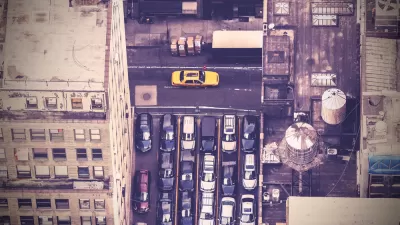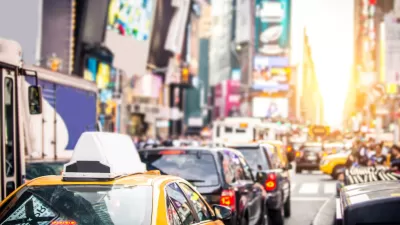Free street parking in much of New York City means lost revenue, but it also affects the urban landscape and the quality of people’s lives. So how much is all that street space really worth?

Justin Fox crunches the numbers to calculate the cost of free parking in New York City. Fox uses various measures, including median income, the cost of added congestion, and land prices. "These calculations were far from scientific, but the narrow range of results they delivered makes me think that a street parking space in Manhattan may really be worth somewhere between $6,000 and $8,500 a year," says Fox.
The cost and true value of parking are of special interest now because congestion pricing in the lower half of Manhattan is slated to start next year, notes Fox. Free parking will be harder to come by as people look for ways to avoid the fees, and the impacts on surrounding neighborhoods, such as increases in congestion as drivers hunt for parking spaces, will only become more apparent.
Fox cites a report from the staff of Manhattan Borough president Gale Brewer that looks at parking policies in seven cities. It suggests that the number of permits needs to be limited and the cost of permits should be high, though these policies would not necessarily need to be applied uniformly across the city. "But in a borough where fewer than 25% of households have cars, and those that do are almost twice as affluent as those that don’t, giving away for free something that appears to be worth more than $6,000 a year doesn’t make a lot of sense," adds Fox.
FULL STORY: How Much Should New York Charge for a Parking Space? A Lot

Study: Maui’s Plan to Convert Vacation Rentals to Long-Term Housing Could Cause Nearly $1 Billion Economic Loss
The plan would reduce visitor accommodation by 25,% resulting in 1,900 jobs lost.

North Texas Transit Leaders Tout Benefits of TOD for Growing Region
At a summit focused on transit-oriented development, policymakers discussed how North Texas’ expanded light rail system can serve as a tool for economic growth.

Why Should We Subsidize Public Transportation?
Many public transit agencies face financial stress due to rising costs, declining fare revenue, and declining subsidies. Transit advocates must provide a strong business case for increasing public transit funding.

How to Make US Trains Faster
Changes to boarding platforms and a switch to electric trains could improve U.S. passenger rail service without the added cost of high-speed rail.

Columbia’s Revitalized ‘Loop’ Is a Hub for Local Entrepreneurs
A focus on small businesses is helping a commercial corridor in Columbia, Missouri thrive.

Invasive Insect Threatens Minnesota’s Ash Forests
The Emerald Ash Borer is a rapidly spreading invasive pest threatening Minnesota’s ash trees, and homeowners are encouraged to plant diverse replacement species, avoid moving ash firewood, and monitor for signs of infestation.
Urban Design for Planners 1: Software Tools
This six-course series explores essential urban design concepts using open source software and equips planners with the tools they need to participate fully in the urban design process.
Planning for Universal Design
Learn the tools for implementing Universal Design in planning regulations.
City of Santa Clarita
Ascent Environmental
Institute for Housing and Urban Development Studies (IHS)
City of Grandview
Harvard GSD Executive Education
Toledo-Lucas County Plan Commissions
Salt Lake City
NYU Wagner Graduate School of Public Service





























